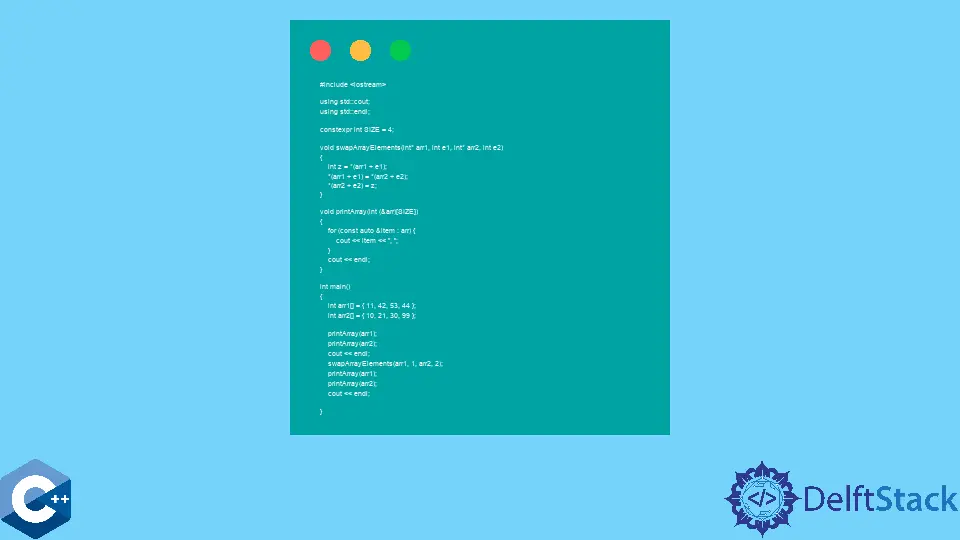C++ 中指向数组的指针
Jinku Hu
2023年10月12日
C++
C++ Pointer

本文将介绍如何在 C++ 中使用指向数组的指针的多种方法。
在 C++ 中使用指向数组的指针交换不同数组中的元素
指针是低级编程的核心元素之一。即使 C++ 试图用引用替换其某些用例,但指针仍然只是内置数据类型,可用于直接处理内存。请注意,C 风格的数组本质上是指向起始元素的指针,并且由于它具有固定大小,因此编译器会在内部自动处理使用 [] 表示法的访问。在下面的示例代码中,我们实现了一个函数,该函数交换来自不同整数数组的两个元素。注意,函数原型使用两个 int*指针来表示需要交换的元素。指针使直接访问给定元素的存储位置成为可能,而不仅仅是修改元素的本地实例。
#include <iostream>
using std::cout;
using std::endl;
constexpr int SIZE = 4;
void swapArrayElements(int* e1, int* e2) {
int z = *e1;
*e1 = *e2;
*e2 = z;
}
void printArray(int (&arr)[SIZE]) {
for (const auto& item : arr) {
cout << item << ", ";
}
cout << endl;
}
int main() {
int arr1[] = {11, 42, 53, 44};
int arr2[] = {10, 21, 30, 99};
printArray(arr1);
printArray(arr2);
cout << endl;
swapArrayElements(&arr1[0], &arr2[3]);
printArray(arr1);
printArray(arr2);
cout << endl;
return EXIT_SUCCESS;
}
输出:
11, 42, 53, 44,
10, 21, 30, 99,
99, 42, 53, 44,
10, 21, 30, 11,
另外,我们可以分别传递数组指针和元素位置。该方法本质上并不比以前的方法更好,但是这里是为了演示可以使用指向数组的指针的不同语言符号。在这种情况下,将添加两个函数参数以指定需要交换的元素的位置。同时,元素访问是使用所谓的指针算术完成的,它可能具有非常繁琐的表示法。请注意,将指向数组的指针增加一个整数值等于将指向一个元素类型的指针增加,这会将指针值移动对象类型的 sizeof 字节。
#include <iostream>
using std::cout;
using std::endl;
constexpr int SIZE = 4;
void swapArrayElements(int* arr1, int e1, int* arr2, int e2) {
int z = *(arr1 + e1);
*(arr1 + e1) = *(arr2 + e2);
*(arr2 + e2) = z;
}
void printArray(int (&arr)[SIZE]) {
for (const auto& item : arr) {
cout << item << ", ";
}
cout << endl;
}
int main() {
int arr1[] = {11, 42, 53, 44};
int arr2[] = {10, 21, 30, 99};
printArray(arr1);
printArray(arr2);
cout << endl;
swapArrayElements(arr1, 1, arr2, 2);
printArray(arr1);
printArray(arr2);
cout << endl;
}
输出:
99, 42, 53, 44,
10, 21, 30, 11,
99, 30, 53, 44,
10, 21, 42, 11,
在 C++ 中使用数组引用将二维数组传递给一个函数
传递二维 C 风格的数组可能很难看,因此最好使用引用符号代替。请注意,以下示例函数将适用于预定义的长度大小的数组,以便函数原型包括每个维的大小值。从好的方面来看,这使利用基于范围的 for 循环进行元素遍历成为可能。
#include <iomanip>
#include <iostream>
using std::cout;
using std::endl;
using std::setw;
constexpr int SIZE = 4;
void MultiplyArrayByTwo(int (&arr)[SIZE][SIZE]) {
for (auto& i : arr) {
for (int& j : i) j *= 2;
}
}
void printArray(int (&arr)[SIZE][SIZE]) {
for (auto& i : arr) {
cout << " [ ";
for (int j : i) {
cout << setw(2) << j << ", ";
}
cout << "]" << endl;
}
}
int main() {
int array_2d[SIZE][SIZE] = {
{1, 2, 3, 4}, {5, 6, 7, 8}, {9, 10, 11, 12}, {13, 14, 15, 16}};
printArray(array_2d);
MultiplyArrayByTwo(array_2d);
cout << endl;
printArray(array_2d);
return EXIT_SUCCESS;
}
输出:
[ 1, 2, 3, 4, ]
[ 5, 6, 7, 8, ]
[ 9, 10, 11, 12, ]
[ 13, 14, 15, 16, ]
[ 2, 4, 6, 8, ]
[ 10, 12, 14, 16, ]
[ 18, 20, 22, 24, ]
[ 26, 28, 30, 32, ]
Enjoying our tutorials? Subscribe to DelftStack on YouTube to support us in creating more high-quality video guides. Subscribe
作者: Jinku Hu
